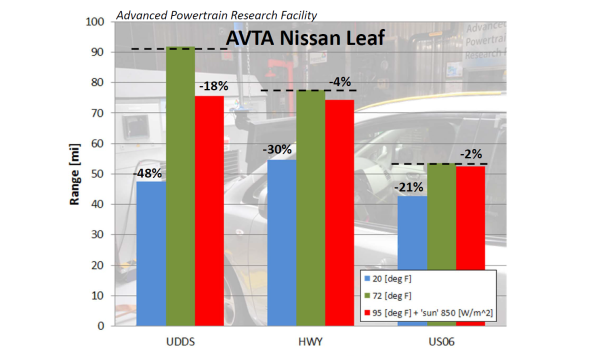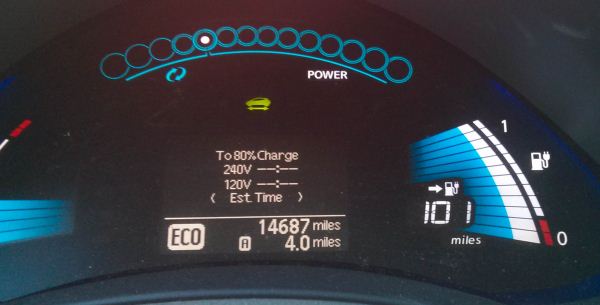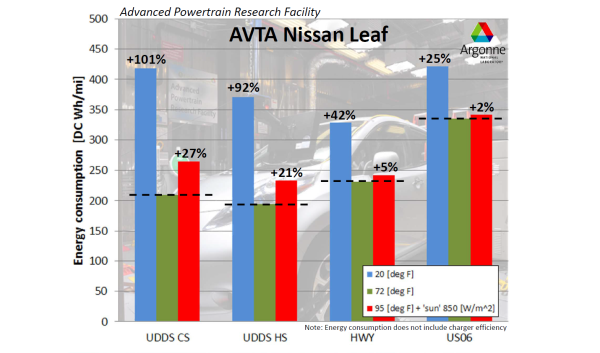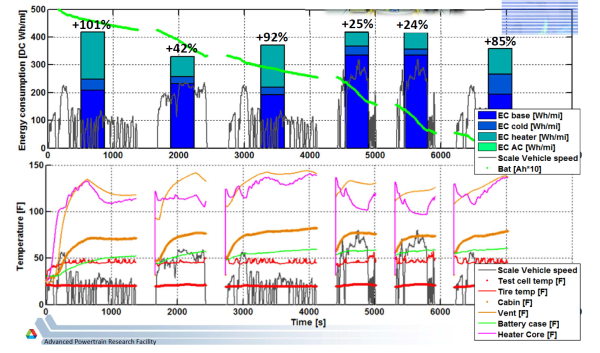The Tesla Model S Controversy: Understanding the Effects of Temperature on Electric Vehicle Efficiency and Range
by Vivek Gowri on February 18, 2013 4:22 PM EST- Posted in
- Auto
- Electric Vehicles
- Tesla Model S
- Nissan Leaf
Thermal Effects on Energy Consumption and Range
Looking at energy consumption, right off the bat, we can see that cold weather has a significant impact on EC - nearly double in urban driving, 40% more in the highway cycle, and 25% on the US06. It’s worth noting here: the Leaf has an 80 kW electric motor, a 24 kWh battery, and a 5 kW resistive heating element.
When broken down further, into a base load case (driving cycle EC at 72F), the amount of extra energy needed to drive the cycle at 20F (listed as EC cold), and then the heater load required to maintain a cabin temperature of 72F, we can see that a significant portion of the additional energy consumption is down to the heater. As with most gasoline cars, driving in sub-freezing temperatures only makes the car about 10% less efficient before heater loads are considered. The mechanically-driven heating elements in conventional vehicles add another 5% or so in terms of mechanical efficiency loss, while obviously the electric heater in the EV is far more costly from an energy consumption standpoint even though it doesn’t increase mechanical losses at all.
(Note: graphs were created by ANL using the raw 10Hz data instead of the filtered 1Hz data available on D3. Available as part of APRF's AVTA Nissan Leaf testing analysis and summary, as presented by Dr. Henning Lohse-Busch. Full presentation available here.)
And while energy consumption is a big deal, range is the be-all, end-all concern for most consumers. With the heater on, that’s a decrease in range by anywhere from 20-50% depending on your drive cycle. That’s a lot. And you can just look at the APRF’s full charge tests at 20F and 72F to see what I mean:
 Think about that - this is a car that, at launch, Nissan claimed had a 100 mile range. My own real-world driving suggests 80-85 a decent estimate. EPA says that number is closer to 73. The APRF’s instrumented testing backs that up (74.1 mile range at 72F), but the same instrumented testing, in 20F weather? 46 miles. That’s it.
Think about that - this is a car that, at launch, Nissan claimed had a 100 mile range. My own real-world driving suggests 80-85 a decent estimate. EPA says that number is closer to 73. The APRF’s instrumented testing backs that up (74.1 mile range at 72F), but the same instrumented testing, in 20F weather? 46 miles. That’s it.













102 Comments
View All Comments
tipoo - Monday, February 18, 2013 - link
They really are the single bottleneck on an incredibly wide spectrum of things, aren't they? From cell phones to being able to wean ourselves off gasoline.JlHADJOE - Monday, February 18, 2013 - link
Unfortunately they're the best we currently have.Lithium Ion is certainly miles better than when we were using NiCD or NiMH.
JPForums - Tuesday, February 19, 2013 - link
Well, there are other options. Silver Zinc (AgZn) batteries are safer than Lithium ION / Polymer as they contain no hazardous materials and don't suffer from thermal runaway. Note: Older Silver Oxide cells contain small amounts of mercury.With lithium based batteries, you have to trade off specific energy (Wh/Kg), energy density (Wh/L), and maximum discharge rate. While advanced Lithium technologies might allow them to achieve higher specific energy or energy density than AgZn, they often come at the expense of each other. For instance, Li-Polymer has higher specific energy than Li-ION, but it also has lower energy density and discharge rate. You would have to use more packs in parallel to achieve the discharge rates of Li-ION or AgZn. They also have a more limited life, even when they aren't in use.
AgZn also has to make tradeoffs, but as less work has been put into them vs lithium, the characteristics don't vary nearly as much. Looking at the overall characteristics of any single AgZn cell paints a much more impressive picture when compared to a single Lithium based cell.
Of course, there are still barriers to entry. AgZn has lower cycle durability. Seeing as Li-ION managed to increase their cycle durability from several hundred cycles to over 1200 cycles, I'd expect AgZn could overcome this with a little work. The largest barrier to entry is most certainly cost. Don't know if there is much we can do about it either. Still, if research can improve AgZn by the amounts that it has improved Lithium based cells, they may become worth the cost.
JPForums - Tuesday, February 19, 2013 - link
Also note Silver Zinc > Silver Oxide.Gokimoki - Tuesday, February 19, 2013 - link
Or forget batteries entirely and go for ultra capacitors. We really need to start pumping in the same kind of r&d funding that li-ion gets into UC's. That would pretty much solve issues with EVs. You'll never get the same energy density as batteries, but being able to recharge in seconds to minutes, weigh MUCH less (partially negating the lower energy density), no toxic components, and virtually unlimited (100 000+) charge-discharge cycles more than make up for it.Daniel Egger - Thursday, February 21, 2013 - link
> You'll never get the same energy density as batteries, but being able to recharge in seconds to minutesYou forgot to mention the fact that there's close to zero infrastructure available where you can actually consume that kind of necessary energy to charge in "seconds to minutes". If it was you'd still have the problem that no power grid operator is going to allow these duty cycles. Plus the cables would be massive and the safety mechanisms ridiculously hard to implement. If they'd finally manage to get the range up to the needed levels that would be even harder to do. Will we see single digit minute charges? Possibly. Seconds? Never ever.
That's exactly the reason why I think battery driven EVs are never going to go mainstream.
greevar - Friday, February 22, 2013 - link
You're right. The grid, as it exists, will not support UC powered cars, but that's not a valid reason to dismiss the idea. The power grid is already an outdated design in need of a change; it might be worth making changes that support new power grid topographies and consumption.Rasterman - Sunday, February 24, 2013 - link
Totally false, "stations" could simply have their own ultracaps that are charged overnight or a long period, or some other method of storing a lot of energy, molten salt, giant flywheels, etc.Getting the energy to the car is only an engineering problem. Drive over an automated plug, station detects you are there and automatically debits your card and moves a coupler 4" to mate with the bottom of your car, which feeds directly into your battery, and offloads kJ of energy in seconds. The interface can be whatever is needed, a 5" connector is needed? No problem, its 100% automated and 100% safe.
After electric cars are mainstream trickle chargers can be installed in or on the sides of roads, no physical contact is required, but would probably be more efficient. Thus you would NEVER have to stop and recharge.
The possibilities are endless, anything can be done.
greevar - Monday, February 25, 2013 - link
Like I said, "as it exists".ikkai - Wednesday, February 27, 2013 - link
Hello, I totally agree with you. A recent breakthrough on super capacitors is exactly what is on your mind and it will definitely change our everyday lives. Here is a video explaining the technology http://youtu.be/OtM6XJlynkkFor those who prefer to just read :), a new carbon based energy storage capacity dubbed as "super supercapacitors" can obtain the same energy density as li-ion batteries while having 100,000+ refill cycles, under a minute charge durations and everything else capacitors are good at.
This thing is like a miracle, they produce it by using normal DVD burners! You can even dispose it by using it as fertilizer for plants! If you got hyped up, continue to read at here (extremetech article): http://bit.ly/w6C0rY
p.s. By the way, thanks to the author of the article :)